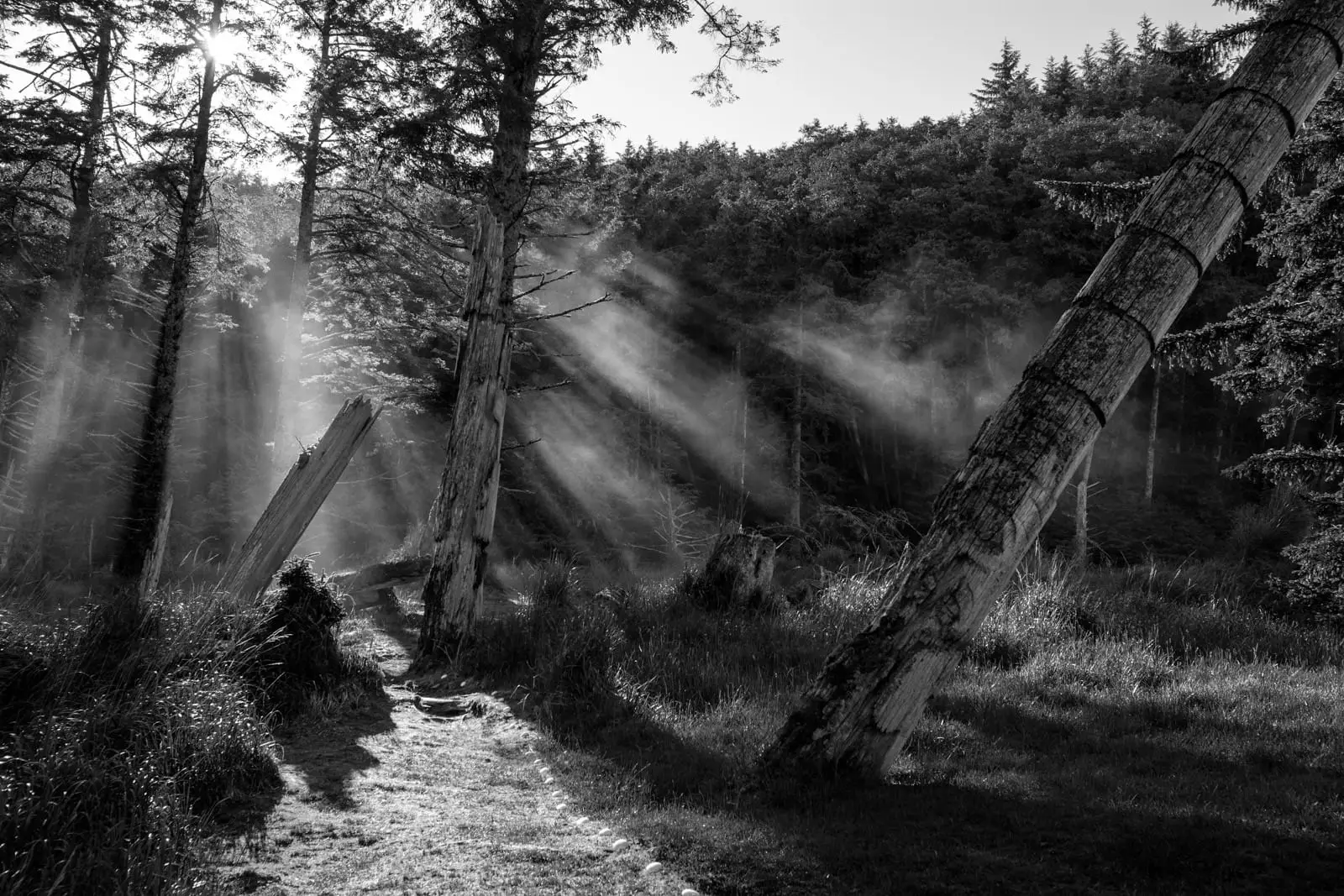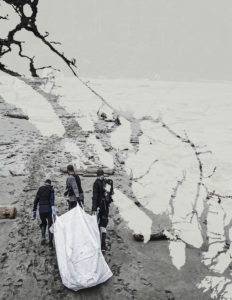
The Haida Gwaii archipelago is situated approximately 100 km west of the mainland coast of British Columbia on the edge of the continental shelf, and some say on the edge of the world. It is the most isolated archipelago on the west coast of North America. Comprised of two large islands (Moresby and Graham) and many smaller islands, Haida Gwaii has a total land mass of approximately 10,000 square km.
The history and culture of the ‘Islands of the People’ – as the name translates – dates back over 15,000 years ago. Discover the ancient history and living cultures as you are transported to the Haida village sites that line the shores of Gwaii Haanas National Park Reserve, National Marine Conservation Area Reserve, and Haida Heritage Site. The otherworldly sites and history of these islands, far surpass a list of seven, but this is where we’ll begin, the rest you might just have to experience firsthand…
1. Haida Gwaii may have been among the first regions colonized by humans on the Northwest Coast”

The lower elevations (and therefore temperatures) of the Queen Charlotte Mountains meant that glaciers formed much later than on the mainland mountains, and melted much earlier. As a result, regions of Haida Gwaii were becoming ice-free ~15,000 years ago, while the mainland remained at a glacial maximum until nearly 10,000 years ago. These differences in the histories of glaciation on Haida Gwaii and the adjacent mainland may also have had important implications for the history of human migration and history on the Northwest Coast.
Because large portions of Haida Gwaii were ice-free, ecosystems were recovering and species were returning, creating conditions that may well have made Haida Gwaii a prime location for settlement by the earliest humans migrating to this region. Indeed, Haida oral history records the retreating glaciers and changing climate at the end of the last ice age, and extensive archaeological evidence shows that the Indigenous Haida have been living on this remote archipelago for at least the past 14,000 years.
2. Sea levels around Haida Gwaii have changed dramatically over the past 15,000 years.

The history and implications of glaciation on Haida Gwaii go hand-in-hand with dramatic changes in sea levels over the past 15,000 years.
Haida Gwaii is situated on the western-most edge of the continental shelf extending from the mainland. As the glaciers on Haida Gwaii melted between 15,000 and 13,000 years ago, the earth’s crust “rebounded” (albeit very slowly), causing local sea levels to drop. Additionally, because glaciers remained on the mainland (eastern edge of the continental shelf), Haida Gwaii was thrust upwards (imagine a teeter-totter with just one person on it), resulting in sea levels ~14,000 years ago being ~150 m lower than they are today. As the glaciers on the mainland also eventually melted ~10,000 years ago (now there’s no one on the teeter-totter), Haida Gwaii sank and sea levels rose dramatically (~165 m) over a period of ~3000 years. Hard to imagine, but true!
This remarkable history of sea level change around Haida Gwaii has some remarkable implications: First, assuming that humans began arriving shortly after Haida Gwaii’s glaciers retreated (i.e. ~14,000 years ago when sea levels were ~150 m lower), campsites and villages of the earliest Haida to have colonized these islands must now be under ~150 m of ocean (making archaeological research tricky, but not impossible). Second, assuming an average lifespan of 60 years, individual Haida would have witnessed sea levels around their homes, villages, and fishing grounds rising by as much as 3 m during their lifetime. Indeed, this “Great Flood” is also well recorded in Haida oral history. Finally, rising sea levels isolated Haida Gwaii and its flora and fauna from mainland populations, setting the stage for local adaptation, and giving rise to numerous endemic (found nowhere else on Earth) species and subspecies, earning these islands the nickname “Galapagos of the North”. The Haida themselves were isolated as well; however, they became skilled canoe builders and seafarers and travelled vast distances to “Seaward Land” and far beyond, but that’s another story…
3. Haida Gwaii has exceptional habitat and species diversity.

In nature, there’s a strong relationship between habitat diversity and species diversity, and we certainly see this in Haida Gwaii where there are a remarkable number of habitats, species, and ecosystems squeezed into a relatively small area.
The west coast of Haida Gwaii, fully exposed to the open Pacific Ocean, is among the most rugged and wave-exposed shorelines in the world. Rugged cliffs rise to wind-sculpted forests of cedar, spruce, and pine, and beneath the ocean surface are stunning communities of seaweeds, invertebrates, and fishes. The west coast is also remarkable for another reason – there’s virtually no continental shelf here. Instead, the seafloor quickly plunges to more than 2 km deep in some places less than a kilometer from shore. As a result, many species that are normally found well offshore are frequently encountered here, including pelagic seabirds (puffins, albatrosses, fulmars, shearwaters, and petrels), whales and dolphins (sperm whales hunting giant squid, offshore killer whales, and humpback, fin, and even blue whales), and pelagic fishes (ocean sunfishes, blue sharks, salmon sharks, and occasionally even basking sharks).
The east coast of Haida Gwaii is entirely different, being quite shallow and having a myriad of wave-protected islands, bays, inlets, sounds, and current-swept narrow passages. An exciting diversity of habitats is found here, including kelp forests, eelgrass meadows, alpine meadows, hanging bogs, and coastal estuaries that support everything from salmon to sundew to sandhill cranes. And it’s on the East coast where the conditions are just right for coastal temperate rainforests dominated by the massive old-growth Western Red cedar and Sitka spruce trees that Haida Gwaii is famous for. Imagine walking through a moss-laden coastal rainforest that is also a seabird breeding colony. Or along a stream where endemic Haida Gwaii black bears deposit salmon carcasses that fuel these forests ecosystems and grow the 1000-year old cedar trees that the Haida used to build ocean-going canoes and carve monumental poles.
Personally, my favourite region is the extreme southern tip of Haida Gwaii, terminating with Cape St. James and the Kerouard Islands. It’s here where the contrasting ocean currents and ecosystems of the east and west coasts literally collide, and an explosion of life results – seals, sea lions, otters, whales, dolphins, sharks, sunfish, salmon, tuna, puffins, murres, auklets, cormorants, eagles, falcons, are all concentrated here to take advantage of the exceptional productivity resulting from this unique combination of geography and oceanography. It’s no wonder the Haida have fished, hunted, and lived here for millennia.
4. The Haida are inextricably woven into the ecological tapestry of Haida Gwaii

Literally translated as “Islands of the People” or “Haida Land”, the Haida people have been inextricably woven into the ecosystems of Haida Gwaii for at least the last 14,000 years.
The Haida world-view is centred around the Supernaturals who have occupied Haida Gwaii for time immemorial. Haida Gwaii rests on the chest of Sacred-One-Standing-And-Moving (Ḵuuya Gyaag̱andal) and when he moves, earthquakes result; Sea Foam Woman (Sguuluu Jaad) emerged on a reef as the Great Flood subsided; and Raven (Koyah), among other adventures and mishaps, discovered the earliest Haida ancestors in a clamshell on Rose Spit.
Archaeological research shows that the Haida have been fishing and hunting here using well-developed subsistence technologies since they arrived. Excavations of shell “middens” (deposits of animal remains accumulated over 1000s of years – think clam and mussel shells, fish bones, sea mammals bones, and fire-cracked rocks) show in vivid taxonomic detail the wide range of shellfish, fish, seabirds, sea mammals, and land mammals that they hunted, fished, trapped, and collected. Given their relationship and deep history with the natural world, it’s perhaps not surprising that the Haida argue that without intact and functioning ecosystems and the innumerable resources they provide, the Haida themselves would cease to exist. And, it’s this world-view that underlies the Haida’s fierce commitment to ecological conservation and sustainable development.
5. Infectious diseases reduced pre-contact populations of Haida by more than 95%.

European exploration of the North Pacific during the late 1700s and early 1800s, in search of the fabled Northwest Passage and fuelled by the trade in sea otter pelts, brought Spanish, English, French, Russian, and American ships and crews to the Northwest Coast. And with these Europeans came infectious diseases (particularly smallpox and influenza) to which indigenous populations had no immunity, resulting in widespread epidemics and mass mortalities. From an estimated pre-contact population of ~20,000 – 30,000 Haida, only ~600 survived, resulting in a tragic loss of language, oral history, traditional knowledge, and culture. This early post-contact era resulted in warfare, amalgamation, and abandonment of villages throughout Haida Gwaii until just two villages were left (and remain today) Skidegate and Masset.
These events also set the stage for the history of Christian missionaries, alcoholism, residential schools, colonialism, and resource extraction (especially old-growth forests and salmon). It’s the legacy of these events that Canada is currently attempting to address through a variety of reconciliation processes with First Nations across the country. The Haida themselves have embarked upon a remarkable journey of cultural revival that includes (but is certainly not limited to) language preservation, youth rediscovery camps, repatriation of the human remains and cultural artefacts taken by museums and collectors, global recognition of Haida art, formation government in the form of the Council of the Haida Nation, and assertion of Haida rights and title in all aspects of the land, surrounding sea, and natural resources of Haida Gwaii.
6. Cultural footprints of the Haida are widespread.

A highlight for most visitors to Haida Gwaii is seeing the monumental mortuary, memorial, and house frontal poles, as well the massive posts and beams of longhouses, that are still standing in several locations and date back to the late 1800s. The most famous of these are found at the ancient Haida village of SGang Gwaay, situated near the southern-most region of the archipelago. Designated as a UNESCO World Heritage Site in 1981 owing to its globally significant cultural heritage, SGang Gwaay is home to a remarkable display of standing mortuary poles (mortuary poles were raised for high-status individuals; cavities at the top of these poles were formed to received bent-wood boxes in which the remains of the deceased were placed).
Many visitors who witness these poles lament the fact that in a relatively short period of time (perhaps 50-100 years), these majestic and inspiring cultural legacies will decay and return to the earth. Fear not. First, this is as the Haida intended. As the mortuaries return to the earth, so too do the souls of the ancestors they contained, allowing them to continue their journeys. Second, controversial as it may be, there are ample examples of Haida poles preserved in museums around the world. But perhaps most importantly, the pre-contact cultural legacy of the Haida is far more extensive than the remains of poles and houses, albeit less conspicuous.
Even a cursory review of the extensive archaeological literature from Haida Gwaii yields one particularly striking fact – wherever a campsite or village could be built and inhabited, on all coasts, and in all bays, inlets, and islands throughout Haida Gwaii, people did live there.
These islands were fully inhabited and the cultural legacy of thousands of years of human prehistory remains everywhere in the form of shell middens, burial islands and caves, food processing sites, defensive sites, bear hunting caves, stone tool quarries and building sites, stone fish traps and wooden stake fish traps and weirs, octopus traps, clam gardens, and many different kinds of culturally modified trees (CMTs). It’s through this lens that we begin to truly appreciate to the deep and pervasive history of the Haida, and we realize that the millennia-old cultural footprints of the Haida will remain here for thousands of year to come.
It’s for this reason that the southern portion of Haida Gwaii was protected by the creation of Gwaii Haanas National Park Reserve AND Haida Heritage Site – the intent of the Haida was not the creation of a national park, but to protect their cultural legacy and future.
European exploration of the North Pacific during the late 1700s and early 1800s, in search of the fabled Northwest Passage and fuelled by the trade in sea otter pelts, brought Spanish, English, French, Russian, and American ships and crews to the Northwest Coast. And with these Europeans came infectious diseases (particularly smallpox and influenza) to which indigenous populations had no immunity, resulting in widespread epidemics and mass mortalities. From an estimated pre-contact population of ~20,000 – 30,000 Haida, only ~600 survived, resulting in a tragic loss of language, oral history, traditional knowledge, and culture. This early post-contact era resulted in warfare, amalgamation, and abandonment of villages throughout Haida Gwaii until just two villages were left (and remain today) Skidegate and Masset.
These events also set the stage for the history of Christian missionaries, alcoholism, residential schools, colonialism, and resource extraction (especially old-growth forests and salmon). It’s the legacy of these events that Canada is currently attempting to address through a variety of reconciliation processes with First Nations across the country. The Haida themselves have embarked upon a remarkable journey of cultural revival that includes (but is certainly not limited to) language preservation, youth rediscovery camps, repatriation of the human remains and cultural artefacts taken by museums and collectors, global recognition of Haida art, formation government in the form of the Council of the Haida Nation, and assertion of Haida rights and title in all aspects of the land, surrounding sea, and natural resources of Haida Gwaii.
7. Gwaii Haanas serves as a model for indigenous communities and protected areas globally.

Throughout the 1960s and 70s, industrial clear-cut logging was ravaging the old-growth forests and salmon-bearing rivers of Haida Gwaii and the Haida saw this as an existential threat to their cultural legacy and future. In 1984, after extensive negotiation with forestry companies and provincial and federal governments, the Haida brought international attention to their plight by blockading logging roads and preventing logging companies from continuing to cut down old-growth rainforest and damaging cultural sites and materials. Haida elders in their 70s and 80s, dressed in full regalia, were the first to be arrested and taken to jail.
To make a long and inspiring story short, the Moresby Agreement was signed in 1985 and would see the southern portion of Haida Gwaii protected through the creation of Gwaii Haanas National Park Reserve and Haida Heritage Site, which was formalized in 1993. Furthermore, Gwaii Haanas would be co-managed by the Haida Nation and the Government of Canada, with equal representation on the newly formed Archipelago Management Board (AMB). In 2010, the Gwaii Haanas National Marine Conservation Area (NMCA) was added to the terrestrial component, which extended the protection of Gwaii Haanas approximately 10 km from shore in all directions into the surrounding Pacific Ocean and seafloor below. In doing so, a globally unique, 5000 km2 protected area was created that extends from seafloor to mountain top. In November 2018, the AMB released the first Gwaii Haanas Gina ’Waadluxan KilGuhlGa Land-Sea Management Plan. Meaning “talking about everything”, this plan sets direction for management of Gwaii Haanas as a single, interconnected ecosystem. As Canadians and global citizens, we should all be proud and inspired by Gwaii Haanas and all that it represents.





